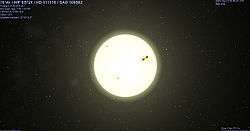70 Virginis
| Observation data Epoch J2000.0 Equinox J2000.0 | |
|---|---|
| Constellation | Virgo |
| Right ascension | 13h 28m 25.81s[1] |
| Declination | +13° 46′ 43.6″[1] |
| Apparent magnitude (V) | +5.00 |
| Characteristics | |
| Spectral type | G2.5Va |
| U−B color index | 0.26 |
| B−V color index | 0.71 |
| V−R color index | 0.39 |
| R−I color index | 0.36 |
| Variable type | none |
| Astrometry | |
| Radial velocity (Rv) | 5 km/s |
| Proper motion (μ) | RA: −236.02 ± 0.24[1] mas/yr Dec.: −575.73 ± 0.19[1] mas/yr |
| Parallax (π) | 55.60 ± 0.17[1] mas |
| Distance | 58.7 ± 0.2 ly (17.99 ± 0.05 pc) |
| Absolute magnitude (MV) | +3.70 ± 0.01 [2] |
| Details | |
| Mass | 1.12[3] M☉ |
| Radius | 1.9 ± 0.1 [4] R☉ |
| Luminosity | 2.92 ± 0.03[5] L☉ |
| Surface gravity (log g) | 3.58 cgs |
| Temperature | 5,406 ± 64[5] K |
| Metallicity [Fe/H] | −0.06[5] dex |
| Age | 7.9[5] Gyr |
| Other designations | |
| Database references | |
| SIMBAD | data |
| Exoplanet Archive | data |
| ARICNS | data |
| Extrasolar Planets Encyclopaedia | data |
70 Virginis (abbreviated 70 Vir) is the Flamsteed designation of a yellow dwarf star approximately 59 light-years away[1] in the constellation Virgo. It is rather unusually bright for its spectral type and may be just starting to evolve into the subgiant phase.
In 1996, 70 Virginis was discovered to have an extrasolar planet in orbit around it.[6] There is also a dust disc with a maximum temperature of 153 K located at a minimum distance of 3.4 AU from the star.[7]
Planetary system
| Companion (in order from star) |
Mass | Semimajor axis (AU) |
Orbital period (days) |
Eccentricity | Inclination | Radius |
|---|---|---|---|---|---|---|
| b | >7.49 ± 0.61 MJ | 0.484 ± 0.028 | 116.6884 ± 0.0044 | 0.4007 ± 0.0035 | — | — |
| Dust disc | >3.4 AU | — | — | |||
References
- 1 2 3 4 5 6 van Leeuwen, F. (2007). "Validation of the new Hipparcos reduction". Astronomy and Astrophysics. 474 (2): 653–664. arXiv:0708.1752
 . Bibcode:2007A&A...474..653V. doi:10.1051/0004-6361:20078357. Vizier catalog entry
. Bibcode:2007A&A...474..653V. doi:10.1051/0004-6361:20078357. Vizier catalog entry - ↑ Holmberg; et al. (2009). "HD 117176". Geneva-Copenhagen Survey of Solar neighbourhood III. Retrieved 2010-02-02.
- ↑ Shaya, Ed J.; Olling, Rob P. (January 2011), "Very Wide Binaries and Other Comoving Stellar Companions: A Bayesian Analysis of the Hipparcos Catalogue", The Astrophysical Journal Supplement, 192 (1): 2, arXiv:1007.0425
 , Bibcode:2011ApJS..192....2S, doi:10.1088/0067-0049/192/1/2
, Bibcode:2011ApJS..192....2S, doi:10.1088/0067-0049/192/1/2 - ↑ Gerard T. van Belle & Kaspar von Braun (2009). "Directly Determined Linear Radii and Effective Temperatures of Exoplanet Host Stars" (abstract). The Astrophysical Journal. 694 (2): 1085–1098. arXiv:0901.1206
 . Bibcode:2009ApJ...694.1085V. doi:10.1088/0004-637X/694/2/1085. (web Preprint)
. Bibcode:2009ApJ...694.1085V. doi:10.1088/0004-637X/694/2/1085. (web Preprint) - 1 2 3 4 Boyajian, Tabetha S.; et al. (July 2013), "Stellar Diameters and Temperatures. III. Main-sequence A, F, G, and K Stars: Additional High-precision Measurements and Empirical Relations", The Astrophysical Journal, 771 (1): 31, arXiv:1306.2974
 , Bibcode:2013ApJ...771...40B, doi:10.1088/0004-637X/771/1/40, 40. See Table 3.
, Bibcode:2013ApJ...771...40B, doi:10.1088/0004-637X/771/1/40, 40. See Table 3. - ↑ Marcy, Geoffrey W.; Butler, R. Paul (1996). "A Planetary Companion to 70 Virginis". The Astrophysical Journal Letters. 464 (1): L147–L151. Bibcode:1996ApJ...464L.147M. doi:10.1086/310096.
- ↑ Trilling, D. E.; et al. (2008). "Debris Disks around Sun-like Stars". The Astrophysical Journal. 674 (2): 1086–1105. arXiv:0710.5498
 . Bibcode:2008ApJ...674.1086T. doi:10.1086/525514.
. Bibcode:2008ApJ...674.1086T. doi:10.1086/525514. - ↑ Butler, R. P.; et al. (2006). "Catalog of Nearby Exoplanets". The Astrophysical Journal. 646 (1): 505–522. arXiv:astro-ph/0607493
 . Bibcode:2006ApJ...646..505B. doi:10.1086/504701.
. Bibcode:2006ApJ...646..505B. doi:10.1086/504701.
External links
- Jean Schneider (2011). "Notes for star 70 Vir". Extrasolar Planets Encyclopaedia. Retrieved 10 October 2011.
- SolStation: 70 Virginis
Coordinates: ![]() 13h 28m 25.8s, +13° 46′ 43.5″
13h 28m 25.8s, +13° 46′ 43.5″
This article is issued from Wikipedia - version of the 10/3/2016. The text is available under the Creative Commons Attribution/Share Alike but additional terms may apply for the media files.
